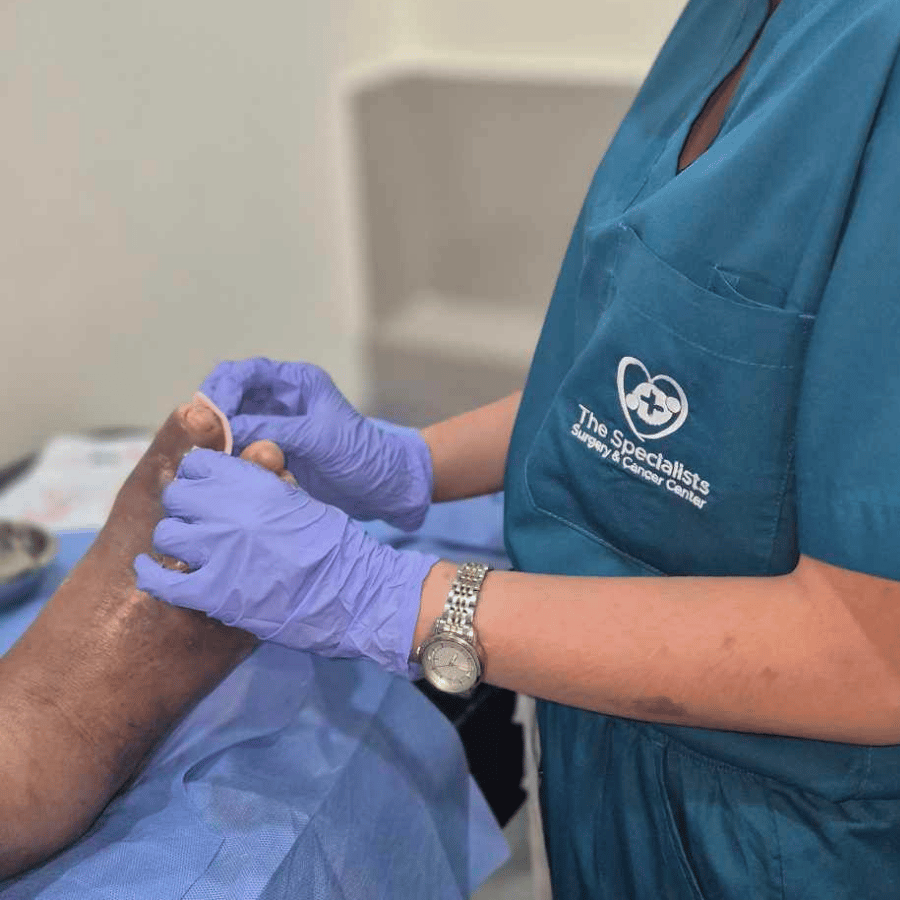Diabetic wounds are among the most serious complications for individuals managing diabetes. Without proper care, these wounds can lead to infections, slower healing, and even more severe health issues. Diabetic wound treatment focuses on effective care for foot ulcers and other chronic wounds caused by diabetes, combining medical expertise, advanced techniques, and patient education. At Kalingap Wound Care Clinic in Quezon City, patients receive professional care designed to heal wounds efficiently while reducing risks of recurrence and complications.
What is Diabetic Wound Treatment?
Diabetic wound treatment is a structured approach that addresses chronic wounds in patients with diabetes. The main goal is to support the body’s natural healing process, prevent infections, and maintain long-term foot health. Wounds related to diabetes typically develop due to poor circulation, nerve damage, or elevated blood sugar levels, which make the skin more vulnerable to injury and slower to heal. The treatment involves a combination of professional wound cleaning, protective dressings, and advanced therapeutic techniques that promote tissue regeneration.
Proper diabetic wound treatment not only targets the current wound but also focuses on preventing future ulcers. This holistic approach helps patients maintain mobility, reduce pain, and enhance overall quality of life.
Signs and Symptoms of Diabetic Wounds
Identifying wounds early is crucial for successful diabetic wound treatment. Common symptoms include persistent sores or ulcers that do not heal, redness or swelling around the affected area, discharge or drainage, and unusual pain or numbness in the feet. Patients may also notice thickened skin or darkened areas, which indicate tissue damage. Slow healing is a key warning sign, and any new wound in a diabetic patient should be evaluated immediately. Recognizing these symptoms allows healthcare providers to implement effective diabetic wound treatment strategies before complications arise.
Who Needs Diabetic Wound Treatment?
Patients who are at risk or already experiencing foot complications benefit the most from diabetic wound treatment. This includes individuals with chronic wounds, those with neuropathy, poor circulation, or a history of recurrent foot injuries. People managing diabetes with uncontrolled blood sugar levels are particularly susceptible to developing foot ulcers and infections. Diabetic wound treatment is also crucial for patients showing early signs of infection, swelling, or tissue breakdown. Prompt care can prevent minor issues from developing into severe conditions that may require surgical intervention or hospitalization.
Diabetic Wound Treatment Procedures at Kalingap Wound Care Clinic
At Kalingap Wound Care Clinic, a structured and patient-focused process ensures effective healing and long-term prevention. The main components of diabetic wound treatment include:
Comprehensive Assessment – The first step involves a thorough examination of the wound. Clinicians assess circulation, tissue health, and infection risk to develop a personalized care plan tailored to each patient’s needs.
Wound Cleaning and Debridement – Removing dead or infected tissue is essential for healing. Skilled professionals carefully clean the wound to create an optimal environment for tissue regeneration and prevent infection.
Specialized Dressings and Offloading – Protective dressings shield the wound from external contaminants, while offloading techniques, such as custom footwear or assistive devices, relieve pressure from affected areas. This allows the wound to heal without added stress.
Infection Control – Continuous monitoring of the wound ensures infections are detected early. When necessary, targeted antibiotic treatments are administered to prevent complications and support safe healing.
Patient Education – Educating patients on foot care, blood sugar management, and proper footwear is an essential component of diabetic wound treatment. Understanding how to care for wounds at home and prevent further ulcers helps maintain long-term foot health.
Benefits of Professional Diabetic Wound Treatment
Receiving expert diabetic wound treatment at a specialized clinic provides numerous advantages. Patients benefit from accelerated wound healing through advanced medical techniques and professional care. Infection risks are significantly reduced, and tissue regeneration is improved, promoting stronger, healthier skin. Long-term guidance on foot care and diabetes management ensures patients can prevent future complications and maintain overall well-being. By addressing wounds early and comprehensively, patients experience enhanced mobility, less pain, and greater confidence in managing their condition.
Patient Education and Aftercare
Successful diabetic wound treatment extends beyond clinic visits. Patients are encouraged to practice proper daily foot hygiene, including cleaning, moisturizing, and inspecting feet for any signs of new injuries or infections. Choosing the right footwear is critical, as proper shoes can prevent pressure points and reduce the risk of ulcers. Blood sugar management is emphasized, with guidance on maintaining target levels to support wound healing. Regular foot examinations help detect potential problems early, allowing timely intervention and reducing the likelihood of recurring wounds. By integrating these practices, patients take an active role in their diabetic wound treatment and long-term foot health.
Why Choose Kalingap Wound Care Clinic?
Patients seeking diabetic wound treatment trust Kalingap Wound Care Clinic for several reasons. The clinic is staffed with experienced professionals specializing in chronic wounds related to diabetes. Advanced medical equipment and treatment techniques ensure patients receive the best possible care. Services are designed to be cost-effective without compromising quality, offering accessible solutions for the Quezon City community. The patient-centered approach prioritizes comfort, healing, and long-term prevention, while the convenient location ensures timely access to specialized care.
Preventive Measures for Diabetic Wounds
Preventing diabetic wounds is an essential part of comprehensive care. Patients are advised to inspect their feet daily for cuts, blisters, or other abnormalities. Maintaining healthy blood sugar levels and a balanced lifestyle reduces the likelihood of skin breakdown. Immediate attention to minor wounds, avoiding walking barefoot, and wearing properly fitted footwear all contribute to preventing ulcers. These preventive strategies complement ongoing diabetic wound treatment, ensuring optimal foot health and minimizing future risks.
Takeaway
Effective diabetic wound treatment combines professional medical care, patient education, and preventive strategies. At Kalingap Wound Care Clinic in Quezon City, patients receive comprehensive solutions designed to heal wounds, prevent complications, and support long-term foot health. Early intervention, personalized treatment plans, and ongoing education ensure the best outcomes for individuals managing diabetic wounds. Protecting foot health through expert care is a crucial step toward living well with diabetes. Contact Kalingap Wound Care Clinic today to schedule a consultation and take proactive steps toward healthier, stronger feet.
FAQs About Diabetic Wound Treatment
How long does it take for a diabetic ulcer to heal?
Healing time varies depending on the wound’s severity, circulation, and patient health. With proper diabetic wound treatment, most ulcers show improvement within weeks, while more severe cases may require longer-term care.
Can diabetic wounds be fully prevented?
While some wounds may be unavoidable due to underlying conditions, diligent foot care, proper footwear, blood sugar control, and early medical intervention significantly reduce the risk of ulcers.
What treatments are available for infected foot ulcers?
Treatment often includes wound cleaning, debridement, specialized dressings, offloading techniques, and targeted antibiotics. Clinics like Kalingap Wound Care Clinic also provide patient education to prevent recurrence.
How often should patients visit a wound care clinic?
Frequency depends on wound severity and healing progress. Some patients require weekly visits, while others may need less frequent check-ups. Follow-up visits are crucial for monitoring healing and preventing complications.
Is diabetic wound treatment covered by insurance?
Coverage varies depending on the insurance provider. Many clinics, including Kalingap Wound Care Clinic, offer assistance in verifying benefits and providing cost-effective treatment options.










